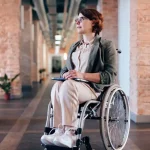I recently attended an AARP Driver Safety course geared towards senior drivers. I wanted the discount I could receive on my auto insurance, but I really needed to figure out how much I would learn in the course.
In fact, I took along some hard candies because I thought they would help me stay awake during class. Actually, I was pleasantly surprised.
As we age, we become more sensitive to bright sunlight and glare, making driving more difficult during daytime hours.
At the same time, night vision among seniors becomes more challenging as we receive less light in our eyes.
Also, depth perception and peripheral vision decrease as we age, making it more difficult to judge distance and speeds.
And, of course, older drivers may have age-related medical conditions such as cataracts and glaucoma that affect driving abilities.
Here are the vision tips discussed in our class that can help improve night vision and drive safely among older drivers:
Editor’s note: The following was taken from page 14 of Unit 2 of the AARP Driver Safety Workbook.
In general:
- Have regular eye examinations by a licensed ophthalmologist or optometrist. This can help detect and address any vision loss or problems that may be age-related among seniors.
- Ask if you should get separate glasses for day and night driving. This can help improve night vision while driving.
- Ask about anti-reflective coatings to reduce glare and improve night vision.
- Don’t use eyeglass frames with wide heavy temples ( side pieces); they may restrict side vision.
- Reduce driving at night, dusk, or dawn when visibility is more difficult.
- Use caution while driving in the rain, fog, or when snow or ice is present.
Before you drive:
- Ensure your windshield, windows ( inside and out), headlights, and tail lights are always clean. This can help improve visual acuity and clarity while driving.
- Wear clean corrective lenses or contacts with an up-to-date prescription. This can help ensure that you have the best possible vision while driving.
- Make sure your mirrors are properly adjusted. This can help improve peripheral vision while driving.
- Have a mechanic check to see if your headlights are properly adjusted to light the road properly and not cause glare for other drivers.
While driving:
- Watch for parked vehicles, cyclists, pedestrians, children, and animals, especially those in your side vision.
- Use extra caution when turning left and judging the speed/distance of oncoming vehicles.
- Choose roads that are well-lit; avoid poorly lit areas.
- Have a good pair of sunglasses handy for daytime glare situations.
- Don’t wear sunglasses or dark or tinted glasses at night, dusk, or dawn unless prescribed by an eye doctor.
- Drive more slowly at night and avoid looking directly into headlights of approaching vehicles; look slightly to the right.
Drivers need to take a vision test and consult with their eye doctor at least once a year, especially after age 65.
Many seniors stop driving at night or during other low-light situations to ensure their safety and the safety of others on the road.
If you have any problems at night, it’s important to stop driving until they are addressed. Additionally, you may have difficulty seeing road signs, pedestrians, and other hazards if you have severe contrast sensitivity impairment.
It’s also important to mention that age alone does not determine driving ability. Many older adults continue to drive safely well into their seventies and beyond.
However, older drivers need to understand the impact of age-related vision changes and take steps to address them to continue driving safely. This may include getting regular eye exams, using specialized glasses for night driving, and adjusting driving habits to avoid challenging situations such as driving at night or in poor weather conditions.
Another study found that fatal crashes among older drivers are more likely to occur at night or during other low light conditions, when visual acuity is reduced.
This highlights the importance of addressing age-related vision changes to improve night vision and prevent impaired driving among older adults.
Final Thoughts
Vision and driving are closely related, and vision changes can affect our ability to drive safely as we age.
Senior drivers should address these changes by getting regular eye exams, using specialized glasses for night driving, and adjusting driving habits to ensure clear vision and safe driving.
Older drivers can continue to drive safely and maintain their mobility and independence by taking these measures.
For more information about AARP Driver Safety, go to aarp.org
Good advice for all. Drive safely out there!

